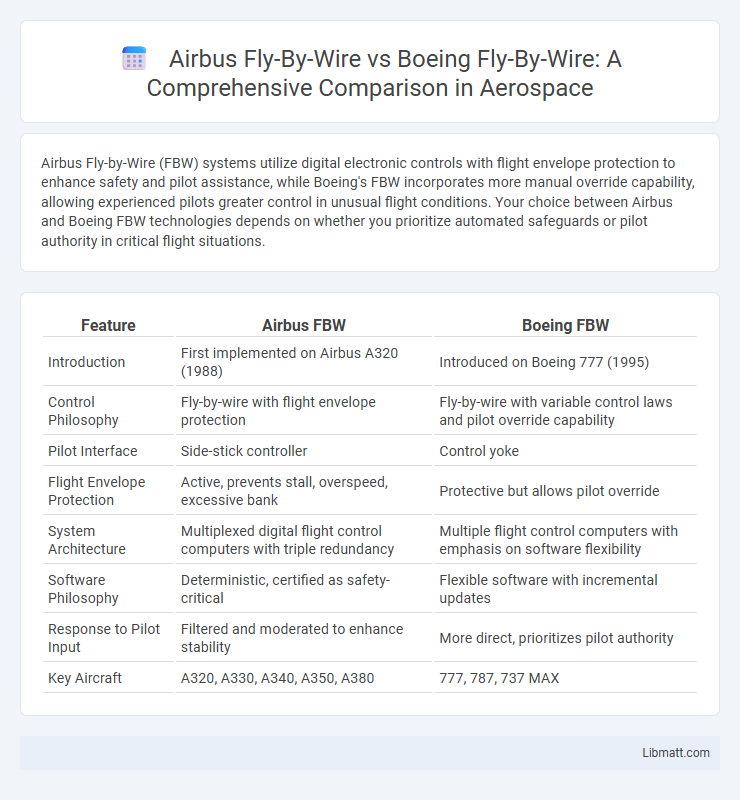Airbus Fly-by-Wire (FBW) systems utilize digital electronic controls with flight envelope protection to enhance safety and pilot assistance, while Boeing's FBW incorporates more manual override capability, allowing experienced pilots greater control in unusual flight conditions. Your choice between Airbus and Boeing FBW technologies depends on whether you prioritize automated safeguards or pilot authority in critical flight situations.
Table of Comparison
| Feature | Airbus FBW | Boeing FBW |
|---|---|---|
| Introduction | First implemented on Airbus A320 (1988) | Introduced on Boeing 777 (1995) |
| Control Philosophy | Fly-by-wire with flight envelope protection | Fly-by-wire with variable control laws and pilot override capability |
| Pilot Interface | Side-stick controller | Control yoke |
| Flight Envelope Protection | Active, prevents stall, overspeed, excessive bank | Protective but allows pilot override |
| System Architecture | Multiplexed digital flight control computers with triple redundancy | Multiple flight control computers with emphasis on software flexibility |
| Software Philosophy | Deterministic, certified as safety-critical | Flexible software with incremental updates |
| Response to Pilot Input | Filtered and moderated to enhance stability | More direct, prioritizes pilot authority |
| Key Aircraft | A320, A330, A340, A350, A380 | 777, 787, 737 MAX |
Introduction to Fly-by-Wire (FBW) Systems
Fly-by-Wire (FBW) systems replace traditional manual flight controls with electronic interfaces, enhancing precision and safety in modern aircraft. Airbus pioneered digital FBW technology with full flight envelopes, integrating flight control laws that optimize performance and protect structural limits. Boeing's FBW approach combines electronic controls with traditional mechanical backups, focusing on pilot authority and gradual integration to maintain pilot familiarity while improving aircraft handling.
Evolution of FBW: Airbus vs Boeing
Airbus pioneered the widespread use of digital fly-by-wire (FBW) systems with the A320 in 1987, integrating advanced flight control computers to enhance safety and efficiency through flight envelope protection. Boeing adopted FBW technology later with the 777 in 1995, blending traditional pilot input with FBW to maintain a more conventional feel while improving performance and reliability. The evolutionary paths showcase Airbus's focus on computerized automation and strict flight control laws versus Boeing's emphasis on pilot control augmentation and incremental integration.
Core Philosophy: Design Differences
Airbus Fly-By-Wire (FBW) systems prioritize enhanced safety through flight envelope protection and a digital interface that limits pilot inputs to prevent unsafe maneuvers. Boeing FBW philosophy emphasizes pilot authority, offering flight control augmentation while allowing more manual override and tactile feedback, preserving traditional pilot control feel. These design differences reflect Airbus's focus on automation and protection, contrasting with Boeing's emphasis on pilot engagement and control flexibility.
Flight Control Laws: Airbus Approach
Airbus Fly-By-Wire (FBW) flight control laws emphasize envelope protection and pilot assistance through multiple control modes such as Normal Law, Alternate Law, and Direct Law, ensuring safety and handling stability. The Airbus system uses digital computers to interpret pilot inputs and automatically adjust control surfaces within predefined limits to prevent stalls, excessive bank angles, and overspeed conditions. This contrasts with Boeing's FBW approach, which offers fewer automatic protections, relying more on pilot authority and manual override capabilities.
Flight Control Logic: Boeing Approach
Boeing's flight control logic in fly-by-wire (FBW) systems emphasizes pilot authority by allowing greater manual control input and tactile feedback, enhancing situational awareness during critical phases of flight. Their design incorporates load alleviation and envelope protection without completely restricting pilot override, fostering a more traditional handling feel. This contrasts with Airbus' FBW, which prioritizes automated protections and control laws that prevent pilots from exceeding set limits.
Pilot Interaction and Automation Levels
Airbus Fly-By-Wire (FBW) systems prioritize pilot interaction through flight envelope protection and computerized control laws that subtly limit pilot input to ensure safety, emphasizing automation that assists without overriding human commands. Boeing FBW integrates a more hands-on pilot interface with variable automation levels, offering greater manual control and feedback while still providing essential protections and system monitoring. Understanding these differences helps you adapt your flying method to either Airbus's automated safeguards or Boeing's pilot-centric control philosophy for optimal aircraft handling.
Redundancy and System Reliability
Airbus Fly-By-Wire (FBW) systems employ multiple independent flight control computers with triple or quadruple redundancy to ensure continuous operation, enhancing overall system reliability. Boeing's FBW architecture integrates dual and triple redundant control computers with cross-monitoring features, emphasizing fault tolerance and safe degradation performance in case of failures. Your aircraft's safety benefits from these redundancy strategies, significantly reducing the risk of total system failure during critical flight phases.
Safety Protocols and Error Management
Airbus fly-by-wire (FBW) systems prioritize multiple layers of automated safety protocols, including envelope protection that prevents pilots from exceeding structural and aerodynamic limits, significantly reducing human error. Boeing's FBW design emphasizes pilot authority with a stabilization system that assists but allows more manual override, focusing on pilot situational awareness and error management through advanced alert systems. Both manufacturers integrate redundant systems and rigorous error detection algorithms to enhance flight safety, but Airbus leans towards automation for error prevention while Boeing balances automation with pilot control for error mitigation.
Pilot Training: Transitioning Between Systems
Transitioning between Airbus and Boeing Fly-By-Wire (FBW) systems requires comprehensive pilot training due to distinct control philosophies and cockpit interfaces. Airbus FBW emphasizes flight envelope protection and uses side-sticks, while Boeing FBW maintains traditional yokes with different feedback mechanisms, impacting pilot muscle memory and response. Your training program must address these differences to ensure safe and efficient operation across both platforms.
Future Trends in FBW Technologies
Airbus Fly-By-Wire (FBW) systems emphasize high automation and advanced flight envelope protection, leveraging digital triple-redundant architectures to enhance safety and pilot assistance. Boeing FBW integrates pilot feedback with adaptive control laws, focusing on intuitive handling and system robustness for varied flight conditions. Future trends include augmented reality interfaces, AI-driven predictive maintenance, and enhanced cybersecurity measures to improve real-time diagnostics and system resilience in both manufacturers' FBW technologies.
Airbus FBW vs Boeing FBW Infographic

 libmatt.com
libmatt.com